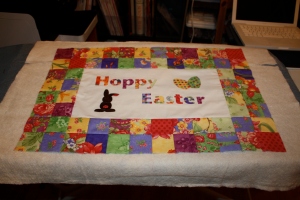Are you excited? Have you been looking forward to learning how you can baste a larger quilt with Misty Fuse, and ALMOST no pins? 😉 It’s really close to pinless, HONEST!! So I’m going to show you how to baste a backing to batting using Misty Fuse. Now it really doesn’t matter, if it’s the quilt top or the quilt backing, because both sides have to be done right? and the trouble here is that I can not show you this quilt, as it is my next Bake Shop goodie, and well, you all know that MUST remain a surprise!!
FYI – The table I did this process on, is exceptionally wide. A typical ironing board might work depending on the size of your quilt. The batting will be layered up which will protect your surface, but chose where you baste your quilt wisely. You are pressing, and dealing with high heat. If you had an area large enough to lay out the entire quilt, it would save you from having to fold.
This quilt backing measures 44 X 55.
A few abbreviations before I begin…
H = Horizontal
V = Vertical
MF = (guess?!) Misty Fuse
 Fold batting in half horizontally. Pin the left and right side to mark the vertical centers of the batting. Also place a pin at the horizonatal center. This will assist you to line up the layers of your quilt accurately. |
Yes! This IS two photos spliced together… what mad photo editing skills right? 😉 |
 Roll out Misty Fuse horizontally along the fold, from edge of batting to opposite edge of batting. |
|
 The backing fabric must be folded with right sides of fabric together. Find the horizontal center before placing quilt. LIne up the H center of batting and backing then pin. Smooth fabric evenly to one side and pin the V center of batting and backing. Repeat for other side. Press evenly starting in center, working out towards the sides. Do not allow iron to contact MF. |
|
 At the edge of the fused area, fold back the backing. Roll out another layer of MF as close to the edge as possible. |
|
 Flip the backing fabric over the MF to press in place. |
|
 The top half of the backing is fused in place. The lower half has been unfolded and now needs fusing. |
|
 Fold back the fabric which needs fusing. Lay out MF along the previously fused edge. Fold fabric back over MF, smotthing out evenly from middle. Press in the same manner. |
|
 Place MF under the remaining area in need of fusing. Fold fabric over, and press to finish fusing the backing to the batting. |
|
Once you have basted the backing, you may then flip the whole thing over, and carry on to baste the front. Do not forget to center the top onto the batting. If you have any questions at ALL, do not hesitate to ask in the comments, or even send me an email. I’m always happy to help. 🙂
Now for the REALITY CHECK!!
Here in Canada, I can purchase a meter ( hehe an extra 3 inches!!) of Misty Fuse at my local quilt shop for $5.
39 X 20 inches = $5.
My quilt = (40 X 50) + backing (44 X 55) = 2.56m + 3.10m = 5.56 m of Misty Fuse
5.56m X $5/m = $27.80
$27.80 to baste a crib size quilt. Seems a little pricey, but consider, if we bought the large 100 yard bolt, directly from Misty Fuse, the price drops to $2.25 per YARD ( so a slight difference in calculation.), which would make the price roughly HALF! Considerable savings right? PLUS!! I just noticed that MF is ALSO available in 35 inch wide! *SWEET*
What it all comes down to my Quilty Friends, is how much do you HATE to baste quilts with pins?! Is it worth the investment? Personally, I think so, but this is a choice you will need to evaluate for yourself. 🙂
Before I sign off, don’t forget to enter the Make Life Layer Cake Giveaway.….
Quilty Hugs,
Bradie




































































